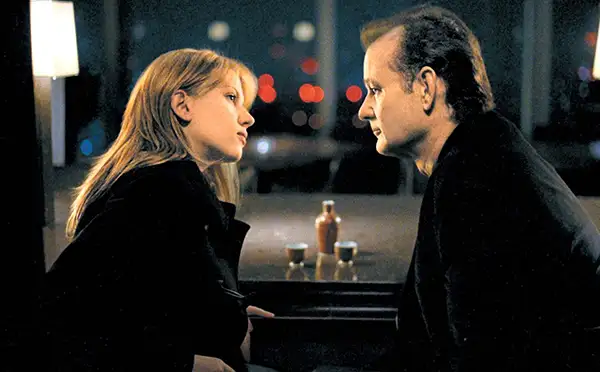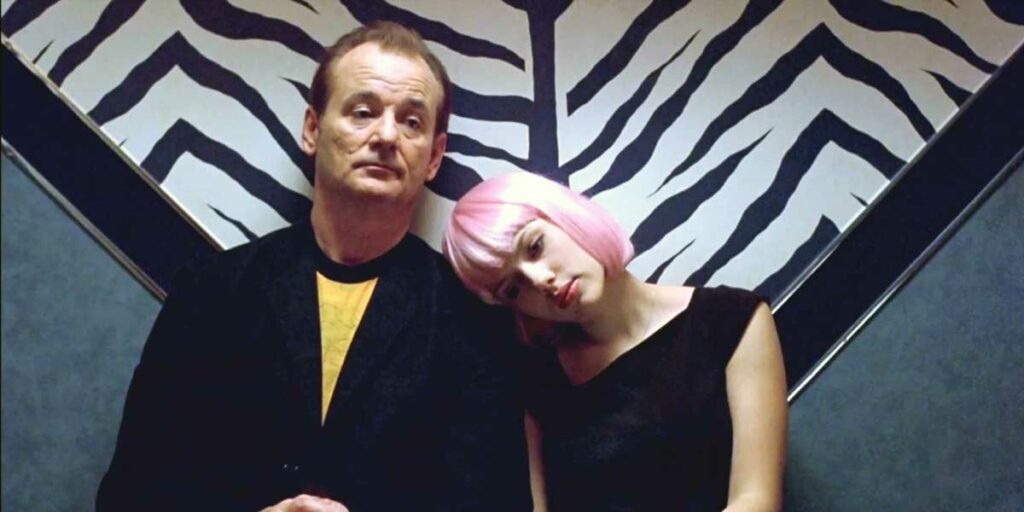Sofia Coppola’s quiet, magnificent Lost in Translation analyzes the most complex human emotions in the most delicate way.
Sofia Coppola’s Lost in Translation (2003) opens with one of the most famous shots of the 21st century. Scarlett Johansson’s Charlotte lies in her hotel bed, with her back turned to the camera and only the lower half of her body in the frame. With this moment, Coppola immediately presents a feeling of isolation, of disconnect. Both are major themes in this film, a masterwork of psychoanalyzing the most complicated human emotions. Coppola’s direction and the performances from Johansson and Bill Murray break down a wide range of feelings – loneliness, love, especially – and what it truly means to be “lost in translation.”
Johansson plays Charlotte, a 25-year-old Yale graduate visiting Tokyo with her eccentric and goofy photographer husband, John (Giovanni Ribisi). Murray plays Bob Harris, a past-his-prime movie star also in Tokyo shooting a whiskey commercial. Charlotte and Bob cross paths with each other, since they both are staying at the same hotel, and eventually introduce themselves. The two grow close over their shared experiences of isolation and familial frustrations.
This film could have easily drifted into a boring melodrama were it not for Coppola’s skill behind the camera. That famous first shot aside, Lost in Translation is filled with awe-inspiring camerawork and shot composition, the most beautiful shots focusing on the Tokyo skyline. Multiple shots portray Charlotte looking desperately out her hotel window at the bustling city. Coppola frequently contrasts the busyness of the city with the loneliness of her two leads, and often utilizes empty space in the frame to highlight their feelings of disconnection. Coppola also places the two together with no barriers to symbolize their connection, while using space, distance, or interfering people when the tension between the two is bad. The film wonderfully provides its audience with visual cues to visually capture what is happening within the plot. Simply put, it’s filmmaking at its finest.
Murray and Johansson may not feel like the most obvious on-screen duo, and that is precisely the point. Johansson was only 17, and Murray was in his 50s. And while one could easily say this a “romantic” film, it might be more apt to define Lost in Translation as an examination of our shared human experiences, and how those experiences – even the struggles – are where we find true connection.
Bob and Charlotte are in similar but different places in their lives, and Murray and Johansson each bring a sense of desperation to their characters. It would not be a stretch to say both actors give their best performances here. Their chemistry, especially in the film’s awkward but ultimately heartfelt ending, shines through in every shot. A standout scene features the two on the town with some friends singing karaoke, a scene that seems to suggest that even in their desperation, hope can be found in the comfort of friendship.

One could give multiple interpretations of the film’s title. In the literal sense, Bob is “lost in translation,” often needing an interpreter to speak for him while shooting the commercial with a Japanese director and crew. On a metaphorical level, it seems to be the case that our main character could be interpreting what is happening with their friendship/relationship in different ways. This is apparent in a later scene where Charlotte becomes upset with Bob for spending the night with the hotel jazz singer. Do they want a relationship? Would it be morally wrong for them to do so, due to their ages and marital statuses? Coppola asks these questions, but the script remains vague enough to let the audience come up with their “translations” of what is taking place. Nothing is spoon-fed to the viewer. Rather, the events in the film play out naturally, in a way that feels real and not melodramatic.
In the film’s closing moments, Bob whispers something inaudible to Charlotte before they go their separate ways. Unanswered questions are a part of life. This moment may prove frustrating for some viewers, which is exactly what Coppola is going for. Lost in Translation is a movie all about frustration, loneliness, confusion, and complexity. But the film also does not present life as simply the negatives, but how those negatives mixed with the positives equal a whole, beautiful life. A scene where Charlotte, at one of her lowest moments in the film, walks through an arcade and witnesses the smiles and joy of those playing, summarizes this point perfectly. Life is all about the tension between the good and the bad. And the moments where we can connect with other humans through those good and bad times are perhaps the most beautiful
Lost in Translation is now available to watch on digital and on demand.

